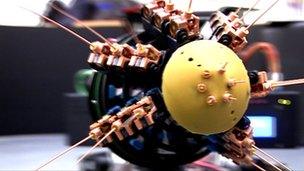Robots of the future designed at new Bristol laboratory
- Published
Geri the robot shows the BBC round the new robotics laboratory in Bristol.
Electrical engineers, psychologists, surgeons and more work together creating robots of the future at the University of the West of England.
There are small robots and big ones; flying robots and swarming robots; even whiskery robots. The variety is astonishing, and the variety is the point of the place.
Prof Chris Melhuish, director of the Bristol Robotics Lab, says the scientists at the lab come from 17 countries and have a range of specialisms.
"As well as electrical engineers and mechanical engineers, which you'd expect, we've got microbiologists, neuroscientists, surgeons, even psychologists," he says.
Dr Alex Lenz shows me Bert, a robot who he has taught to pick up a metal leg from a table.
"Get leg three", he commands and Bert obeys. The robot sees the leg on the table in front of him and calculates a route to pick it up. Importantly, the leg can be anywhere. This is not a pre-programmed action, but a new manoeuvre worked out each time by the robot.
'Do dull work'
Bert's fist closes on the leg and he waits for another command. "Hand over," Dr Lenz says. So Bert picks up the leg and offers it forward.
Dr Lenz says: "Bert can sense when you have taken the leg, and then he releases it automatically."
For people, of course, this is child's play. How often do you hand over a pen, a book, a cup of tea? But to create a robot that can interact like this is hugely complex.
Bert is built with electrical and mechanical engineering; linguistics and computer science; and a good dose of human psychology too.
Dr Lenz imagines that a small manufacturing facility, where hundreds of different products are made, would find a robot like Bert useful. Unlike a mass production line, such as a car plant, each task is slightly different.
"If you can teach this robot to help you, it can do the dull work alongside humans who do the smarter stuff."
The Bristol Robotics Lab is the largest of its kind in the UK, but you will not see Bert, or any of its robots, working in real factories. It is an academic lab, exploring the technologies that will build the robots of the future. And, sometimes, using robots to help push back other scientific frontiers.

The Shrewbot mimics a rat's whiskers to find its way
Round the corner, twitching its way across the lab, I meet Dr Martin Pearson's Shrewbot.
This robot scuttles across the floor, a battery of artificial whiskers flicking back and forth from its nose.
"He's looking around the environment using his whiskers only," Dr Pearson says. "He's totally blind."
As the whiskers touch the wall, or the lens of the camera, they feed back information to the robot's computer, which acts accordingly. A slight touch and it turns and investigates more. A bump on the nose and Shrewbot turns tail.
"This is pure biology," Dr Pearson says. "We're really interested in how rats and shrews move their whiskers, what they can determine with their whiskers. And making our own has taught us a huge amount."
There are projects like this everywhere in the lab. Tiny drones buzz round a flying arena, piloting themselves round hazards and towards targets. One day engineers will toss them into nuclear meltdowns to gather vital information from safety.
'Wonderful fusion'
Prof Melhuish says the work in the lab is a "wonderful fusion of curiosity and technology".
"Whenever someone gets a robot working for the first time, they tell us, and we stop what we're doing to come and see."
These are not the robots you see in factories repeatedly lifting, pulling, or painting. They seem more intelligent, more adaptable. But the scientists here are careful not to call them "he" or pretend they are more than machines.
As I say goodbye to Bert, I can't resist that sci-fi question. "Could Bert become a robot butler?"
Dr Lenz smiles. "It might happen, and it might surprise me. But in the environment of everyday life, with so much going on, there's a long way to go."
- Published3 May 2012
- Published8 November 2010